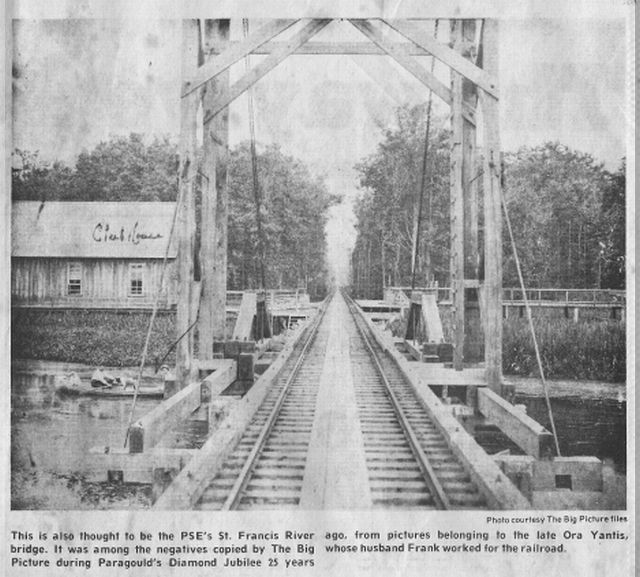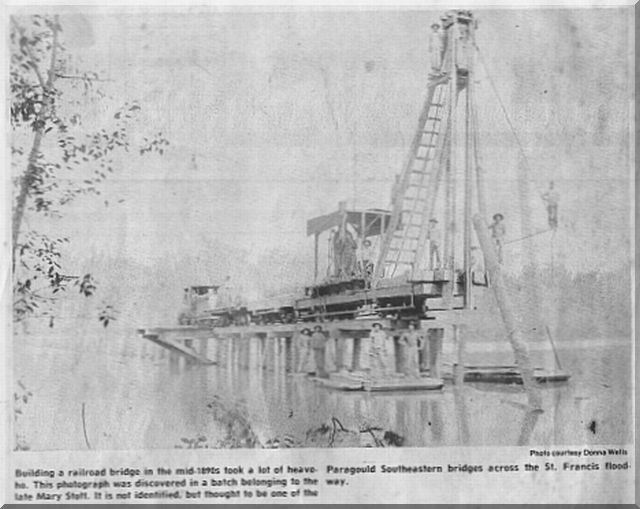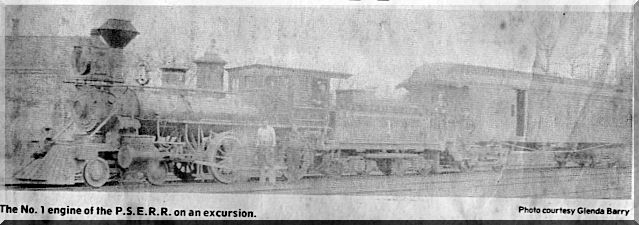

Greene County, Arkansas
Centennial Edition


|
Building a railroad
in the mid-1890s took a lot of heave-ho. This photograph was
discovered in a batch belonging to the late Mary Statt. It is not
identified, but |
This is also thought to be the PSE's St. Francis River Bridge. It was among the negatives copied by the Big Picture during Paragould's Diamond Jubilee 25 years ago, from pictures belonging to the late Ora Yantis, whose husband worked for the railroad. |
The railroads created towns, industries, new opportunities
Railroads created Paragould and gave it a name, coined from those of two national tycoons -- J. W. Paramore and Jay Gould. Paramore's Texas and St. Louis (we call it the Cotton Belt now) and Gould's St. Louis Iron Mountain and Southern (Missouri Pacific) were built in the early 1880s. Both were constructed to transport cotton north to the compresses in St. Louis. Some say the competing railroads were racing each other as they laid their lines through Greene County. But written records don't say who finished first. According to Missouri Pacific records, its seven miles of track between Gainesville and "Parmly" were completed April 1, 1882, as part of a branch line between Knobel and Forrest City. First called the Crowley's Ridge Branch, it later became known as the Helena Branch. |
The main line to which
this branch connected at Knobel was actually the first major railroad
to pass through Greene County. It sliced through the northeast corner from
O'Kean to Peach Orchard and had a station at Delaplaine. Gould initiated the Crowley's Ridge Branch in a move to under cut his rival, Paramore, whose narrow-gauge line extended through Arkansas from Texarkana to Bird's Point, MO. The section to Bird's Point to Clarendon, Ark.; including the tracks through Paragould, was completed about June 1882. The railroad officials don't know exactly when their tracks were laid here. In 1886, the railroad -- by this time had been renamed the St. Louis Arkansas and Texas Railway -- would perform the remarkable feat of converting all 419 miles of its track from narrow to standard gauge in just 24 hours. In 1893, the same railroad -- but this time having been renamed Louis Southwestern, still it's official |
name -- joined with the
Bertig Brothers and J. F. Hasty and Sons to rescue the ailing Paragould and
Buffalo Island Railway, a narrow-gauge tramroad that had begun operations
six years earlier. According to legend, the first line built on logs with
wooden rails and operated by a concern known as the Tennessee Factory Co.
The line was used primarily to serve the Ware-Rossen Stave Mill.
When that mill went into receivership, the line remained idle until Henry Wrape, the Bertigs and the Hasty's convinced the Cotton Belt to furnish them with heavy rails and a narrow gauge locomotive. The named was changed to Paragould Southeastern in 1863 and the line converted to standard gauge. Extensions were built to Cardwell, Hornersville and Blytheville in 1895, 1897, 1903 and 1907. Although the Cotton Belt held a controlling interest, the PSE |
operated as an independent company
until 1914 when it was absorbed. Like the other railroads before it, the PSE created boom towns in it's path, providing a means of hauling to mill and market the rich Hazelwood timber that was being felled through-out eastern Greene County. The timber is no more neither is the PSE, it having been abandoned by the Cotton Belt in the late 1970's. The job of dismantling the road is just now being completed but a grassless stretch that was once a road to riches can still be detected and a few dismantled ties and track rails offer evidence of what used to be. But soon the grass will obscure even those reminders and the PSE, will indeed he only a memory.
Transcribed by: Sandy Hardin ~ 2/16/07 |

Return to Greene County, Arkansas Centennial Edition